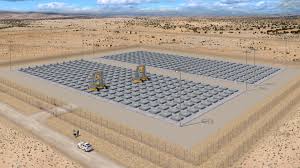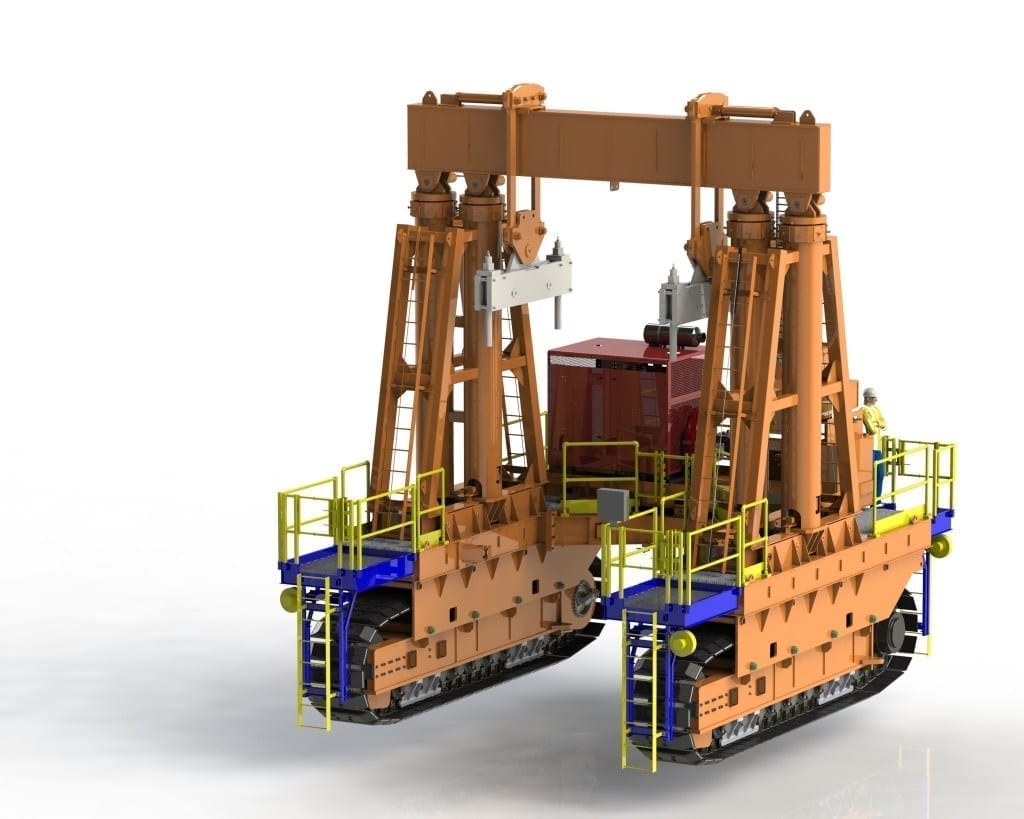The post Another Court Challenge for Nuclear Waste Storage Site appeared first on POWER Magazine.

Another legal challenge has been filed against the ongoing effort to build a storage site for U.S. nuclear waste in the New Mexico desert.
Beyond Nuclear, among the environmental and other groups opposed to the project that would be built by Holtec International, on June 4 filed a petition for review in the U.S. Court of Appeals for the District of Columbia Circuit. The group has asked the court to review the U.S. Nuclear Regulatory Commission’s (NRC’s) rejection of their earlier petitions against the project.
Holtec International, a private company that specializes in spent nuclear fuel storage and management, wants to build what it calls its HI-STORE Consolidated Interim Storage Facility (CISF) in southeastern New Mexico. The site in the desert near Carlsbad has been the subject of opposition from several groups, including state lawmakers and Gov. Michelle Lujan Grisham.
Supporters of the storage site have said it would bring an estimated $ 3 billion in capital investments to the region, and create about 100 jobs. Project opponents include environmental groups, at least 12 local governments, and several state lawmakers including the governor, who have said they are concerned the temporary storage site could become a permanent repository absent a federal solution.
Another CISF is being planned in Texas. Interim Storage Partners, a joint venture of Waste Control Specialists and Orano CIS, wants to build and operate a storage site in Andrews County, a project also under review by the NRC with a decision expected next year.
Tons of Used Nuclear Fuel
Holtec, based in Jupiter, Florida, in its initial application for the HI-STORE facility said its plans include “storage of up to 8,680 metric tons of uranium in commercial used fuel (500 canisters) with future amendments for up to 10,000 storage canisters total.” Holtec said sites across the U.S., primarily at nuclear power plants, have “more than 80,000 metric tons of used nuclear fuel in storage and more is being generated every day at a rate of 2,000 metric tons per year.”
Holtec has said “The HI-STORE CISF provides a site to aggregate the used nuclear fuel canisters presently stored across the country at independent used fuel storage installations into one secure location.”
The Beyond Nuclear group has said the NRC cannot issue Holtec a license for the New Mexico facility because the company’s application includes a provision that the U.S. Department of Energy (DOE) could be the owner of the facility’s nuclear waste. The group has said approval of the application with that provision would violate the Nuclear Waste Policy Act (NWPA), which prevents the government from taking ownership of nuclear waste from private utilities before a permanent repository is in operation. There is no federal repository for nuclear waste.
The NRC in May 2019 dismissed legal challenges to the storage site from groups including Beyond Nuclear, the Sierra Club, and others. Holtec applied for a license from the NRC in 2017 to build and operate the New Mexico facility, which it said would hold waste from reactors across the U.S. “temporarily until a permanent, federally-managed repository is established.”
Kevin Kamps, a radioactive waste specialist with Beyond Nuclear, told POWER on June 9, “I think the real motivation for the nuclear power industry is to transfer the responsibility for waste to the DOE, which means the taxpayers, and all it does is put it in a temporary location. [The waste] could wind up going right back to the East Coast where it came from. That’s a multiplication of the transportation risks for no good reason.”
Challenge to Earlier Rulings
Beyond Nuclear in a June 4 news release said, “Since it contemplates that the federal government would become the owner of the spent fuel during transportation to and storage at its CISF, Holtec’s license application should have been dismissed at the outset.” The group said it is challenging the NRC’s earlier rulings in favor of licensing a “so-called consolidated interim storage facility [in New Mexico] for up to 173,600 metric tons of irradiated nuclear fuel, more than twice what currently exists in the country.”
Holtec in court has acknowledged “that the NWPA would prevent DOE from taking title to spent nuclear fuel and therefore … DOE could not be a CISF customer.” The company also said “it hopes Congress will change the law to allow DOE to enter into temporary storage contracts with Holtec.” The NRC, though, said that the “mere mention of DOE” does not invalidate Holtec’s license application, and wrote, “We disagree with the assertions that the license would violate the NWPA.”
Joe Delmar, senior director of government affairs and communications for Holtec International, in a June 9 email to POWER said, “The NRC issued the draft environmental impact statement in March. Due to the Coronavirus, the public comment period was extended to July. The NRC’s final environmental impact statement and safety evaluation report are scheduled to be issued in March 2021 along with a final determination on issuing the license.”
Holtec in an earlier statement to the Albuquerque Journal said it “believes that the Atomic Safety and Licensing Board and the [NRC] were correct in denying the petitions argument … having to do with ownership transfer to the federal government of spent fuel to be stored at the HI-STORE facility.”
Opposition Groups Are Many
Kamps told POWER that the provisions in the NWPA are to protect states such as New Mexico from being forced to store nuclear waste before it could be moved to a permanent storage site. “It’s very likely that it will become a de facto permanent storage site,” Kamps said. “It’s interesting to look at the other groups that oppose this. The governor noted that New Mexico values its oil and gas industry, and their concern is that if the worst were to happen, with a release of nuclear waste, that would end that industry because no one would be able to work on that land. There are other industries, agriculture, ranching, cattle farms … they all are concerned about the risks. We have a lot of support from New Mexicans, including the public lands commission and the All Pueblo Council of Governors, who have spoken out about the transportation risks.”
The All Pueblo of Governors is a group of 20 governors of New Mexico’s Pueblo nations who support Native American culture and their peoples’ land and water rights. Mining companies with interests in the area also oppose the storage site. The oil and gas industry’s concerns stem from the project’s location in the Permian Basin, one of the nation’s most-active drilling sites.
The issue of storage of waste from U.S. nuclear power plants has been contentious for years. Congress, when it passed the NWPA in 1982, called for the development of repositories for the nation’s high-level nuclear waste and spent nuclear fuel. The Yucca Mountain site northwest of Las Vegas, Nevada, became the focus of a permanent storage site, and the federal government spent billions of dollars assessing the viability of a deep underground storage facility there.
Local opposition to that site stifled the project. Harry Reid, a Democratic senator from Nevada and then-Senate majority leader, vehemently opposed efforts to use Yucca Mountain, and the Obama administration scrapped funding for the site in 2009. The NRC in 2016 issued a court-required final environmental impact statement for the site, which some thought could revive the project. President Donald Trump early in his term had budgeted funding for the project, but later reversed that stance.
Holtec Developing SMR
Holtec, meanwhile, continues to develop its SMR-160, a light-water-based pressurized small modular reactor that would generate 160 MWe (525 MWth), using “simple and passive systems to achieve aggressive safety goals and economic performance,” according to the company. The reactor, currently under regulatory review in Canada, is being developed by Holtec and its subsidiaries, and investment partners in the project include Mitsubishi Electric Corp., SNC-Lavalin, and Exelon Generation.
Holtec has selected Framatome to supply nuclear fuel for the SMR, using Framatome’s 17 x 17 GAIA fuel assembly. Holtec recently said, “By adapting the SMR-160 to utilize standard Pressurized Water Reactor fuel in its core design, Holtec has substantially eliminated risks associated with nuclear fuel, ensuring fuel-related operational experience from the current light water reactor fleet operating world-wide is relevant to our reactor.”
Holtec in March 2018 signed a memorandum of understanding with Energoatom, the state-owned nuclear power operator in Ukraine, in which that country would become a manufacturing hub for SMR-160 reactor components. Holtec has said the Ukraine site would mirror its New Jersey manufacturing center, and would be one of four such plants operating worldwide by the middle of the decade.
The company has said it wants an SMR-160 reactor ready for deployment by 2026.
Testing Completed for Heavy Load Hauler
Holtec also on June 5 said it had successfully completed a factory test of the company’s HI-TRAN 300, a vertical heavy-load hauler designed by the company’s Nuclear Power Division to move dry spent nuclear fuel storage system components. The company said the HI-TRAN 300, which also can execute inter-cask canister transfers, could be used at the New Mexico storage site. The hauler was manufactured and tested at Holtec’s facility in Camden, New Jersey.

The company has said the hauler likely also will be used to support the company’s deployment of its SMR-160.
Holtec in a news release said it developed HI-TRAN “to solve the transporter reliability problems procured from third parties that occasionally have plagued some dry store campaigns in the industry.” The company said HI-TRAN is built as a “safety-significant machine and has certain unique reliability features that differentiate it from other machines sold in the industry.”
The HI-TRAN 300 weighs 121 metric tons. According to Holtec, the machine “moves on two parallel caterpillars to minimize ground pressure and has zero turn radius. It features four hydraulic lifters and has a rated lift capacity of 300 tonnes, which is sufficient to haul the heaviest loaded cask supplied by Holtec.”
Holtec said deployment of the HI-TRAN 300 transporter “eliminates reliance on subcontractors during cask loading campaigns.”
—Darrell Proctor is associate editor for POWER (@DarrellProctor1, @POWERmagazine).
The post Another Court Challenge for Nuclear Waste Storage Site appeared first on POWER Magazine.